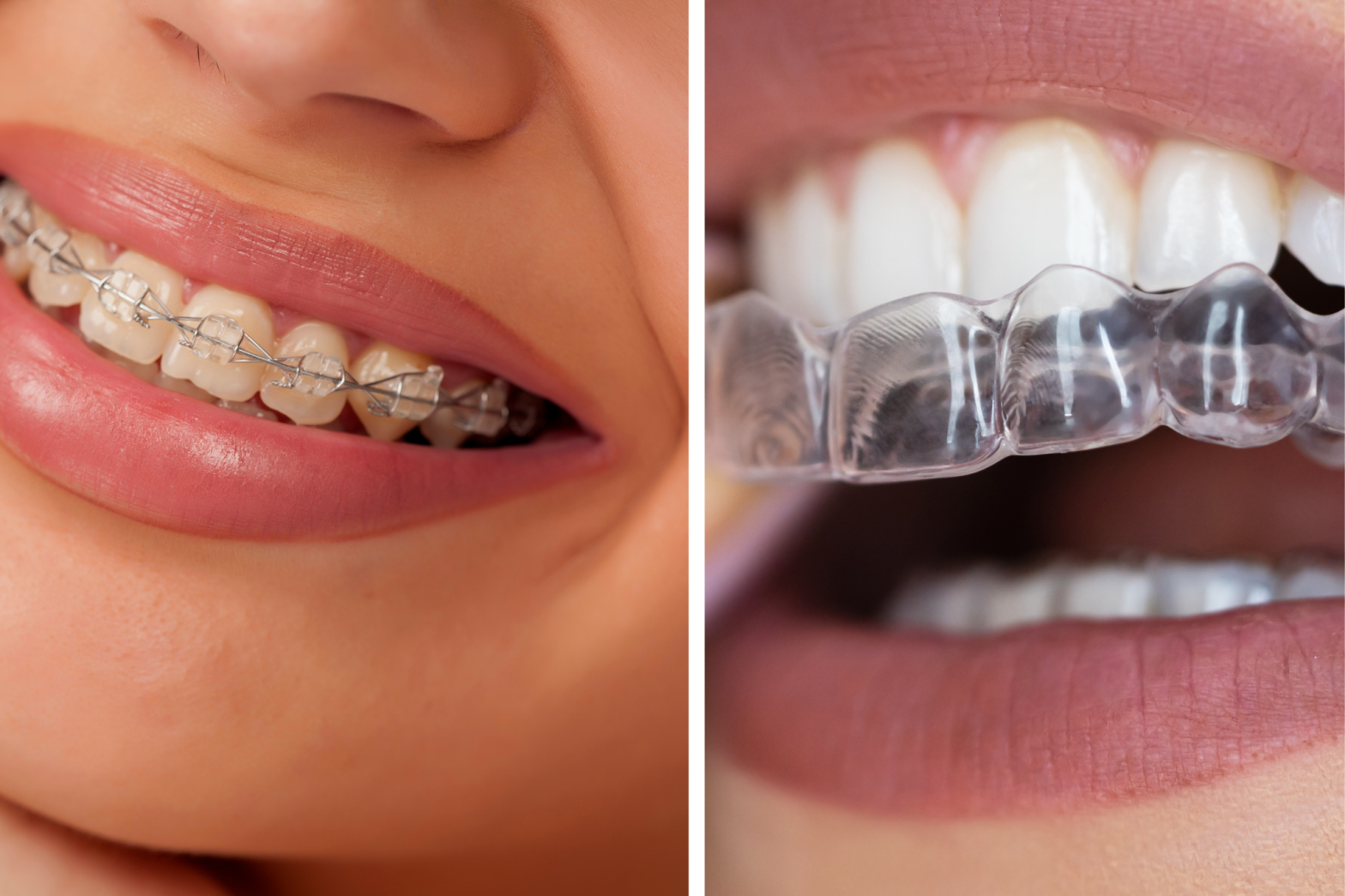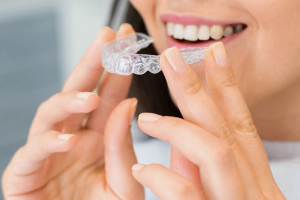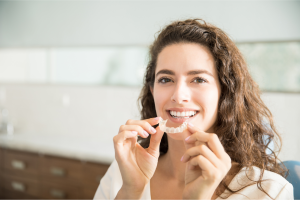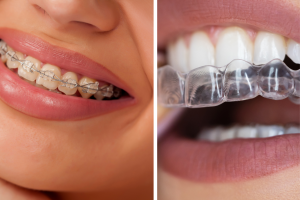Wanting a straighter smile is not just a teenage concern; more adults in the UK are exploring orthodontic treatments than ever before. In London and across the country, clear or invisible aligners have become a popular alternative to traditional braces.
They promise less visible hardware and the ability to remove the appliance when eating, making them appealing to professionals and anyone self‑conscious about wearing braces in social settings.
Before you decide whether invisible aligners or fixed braces are right for your smile correction, it’s worth understanding how each works, the benefits they offer and the limitations you should consider. Below is a research‑driven comparison using authoritative UK sources.
How Traditional Braces and Invisible Aligners Work
Traditional braces have been used for decades to straighten crooked, crowded or protruding teeth, close gaps and correct bite problems. The NHS explains that orthodontic treatment “almost always involves using braces” to move teeth into the correct position. Fixed appliances consist of brackets glued to the front of the teeth and connected by wires.
The brace is adjusted every few weeks by the orthodontist to gradually move teeth; treatment usually lasts between 12 months and 2½ years, with check‑ups every 4–10 weeks. There are variations within fixed braces, including metal brackets (the standard NHS option), ceramic or clear brackets and lingual braces that attach to the back of the teeth. While young people under 18 can receive metal braces on the NHS if clinically necessary, adults generally pay privately.
Invisible aligners (popular brands include Invisalign) are clear plastic trays custom‑made to fit over your teeth. You receive a series of numbered aligners and switch to the next one every 10–14 days. Each tray is worn for most of the day (usually 20–22 hours) and removes slight tooth movements until your teeth reach their planned positions. Unlike braces, you take the aligner out to eat, drink and brush.
The technology can treat many common issues such as crowding and overbites; attachments are sometimes added to teeth so the aligner can grip better. NHS guidelines describe aligners as “thin, clear, flexible plastic mouthguards” available privately. Dental practices in London have embraced invisible aligners, offering treatment plans that include before‑and‑after visualisations so patients can see their expected results.
Advantages of Invisible Teeth Aligners
One of the chief reasons invisible teeth aligners have taken off in London is aesthetics. A well‑known Whitehall clinic notes that clear aligners are “aesthetically pleasing” because they are transparent, making them less visible than traditional braces. This subtle appearance can be important for adults who want to straighten their teeth without drawing attention at work or social events. Aligners are also removable, allowing you to eat and drink without restrictions. Removing them for meals means you don’t have to navigate food getting caught in wires, and it enables thorough brushing and flossing before replacing the aligner.
The custom‑made trays exert gentle, continuous pressure, often resulting in shorter treatment times for mild to moderate cases. Because aligners are changed every couple of weeks rather than tightened by an orthodontist, patients typically require fewer in‑office appointments.
A Coventry dental practice reports that Invisalign patients make “fewer trips to the dentist” compared with those wearing fixed braces. The absence of metal brackets and wires can also make aligners more comfortable, avoiding the mouth ulcers and irritation sometimes caused by braces.
For adults or teens who play musical instruments or participate in contact sports, the removability of aligners provides flexibility. You can take them out for a performance or practice session, though wearing them as recommended (20–22 hours per day) is crucial for success. Many London practices even offer digital “before and after” simulations to help patients visualise how invisible aligners can transform their smile.
Advantages of Traditional Braces
Fixed braces remain the gold standard for complex orthodontic problems. The British orthodontic community emphasises that fixed braces are “very effective, making it great for complex and severe cases”.
Because the brackets are glued to your teeth and the wires are adjusted regularly, braces deliver precise control over tooth movement and can correct severe crowding, rotated teeth and bite issues that aligners may not handle. Once fitted, they require less self‑discipline—there’s no risk of forgetting to put them back in—making them a reliable choice for children or forgetful adults.
Another advantage is cost. Some practices note that traditional braces are “often cheaper than Invisalign”, and London’s Whites Dental reports that braces cost roughly £2,100–£3,995, while Invisalign averages £1,695–£3,295.
Although Invisalign can sometimes be cheaper for mild cases because it requires fewer appointments, fixed braces remain the most cost‑effective option for complex treatment, particularly when compared with ceramic or lingual variants. Fixed braces are also available free on the NHS for under‑18s who need them.
Disadvantages of Invisible Aligners
Despite their appeal, invisible aligners are not suitable for everyone. Dental practices caution that the success of aligner therapy “relies on consistent wear,” which can be challenging for some individuals.
You must remove the aligner every time you eat or drink anything other than water and brush your teeth before putting it back, which requires diligence. Keeping the trays clean and storing them properly involves ongoing maintenance. Patients also report tenderness when switching to a new aligner and are advised to avoid very hard or sticky foods during treatment.
Clear aligners may not be appropriate for severe malocclusions or cases involving significant tooth rotation. UK orthodontists note that they are “not suitable for very complex and severe cases”.
Dentists can add attachments or use variants like Invisalign Full for more serious issues, but treatment may take longer and cost more. Additionally, aligners are generally not provided by the NHS, so patients must pay privately.
Disadvantages of Braces
The biggest drawback of fixed braces is visibility. Even ceramic or tooth‑coloured versions have brackets and wires that can be seen when you smile. The NHS notes that fixed braces are typically made from metal, and a Coventry dental practice acknowledges that treatment is “less discreet” and may require diet changes.
London’s Whites Dental lists several disadvantages: soreness after each tightening, difficulty cleaning around brackets, risk of wires snapping and a need to avoid hard, sticky or chewy foods. Food frequently becomes trapped in the braces, so diligent brushing and flossing is essential to prevent decay.
Maintenance appointments are also more frequent because the orthodontist needs to adjust the wires regularly. Many patients experience tenderness following these visits. For people with busy schedules, the commitment of regular check‑ups can be inconvenient.
Costs and Access in the UK – What to Expect
In the UK, cost can be a decisive factor. The NHS provides metal braces free of charge for children and teens under 18 when a dentist determines they’re necessary. Adults generally have to pay privately for any orthodontic work.
In London, Invisalign treatment typically ranges between £1,000 and £3,295, whereas fixed braces cost around £2,100 to £3,995. These figures include mild to moderate cases; severe cases requiring complex interventions often cost more. One reason Invisalign sometimes costs less is that patients visit the dentist roughly every 4–6 weeks rather than monthly.
Choosing Between Invisible Aligners and Braces
There is no single answer to whether invisible aligners are “better” than braces. The right choice depends on your orthodontic needs, lifestyle, budget and willingness to commit to the treatment plan. we discussed regarding Clear Aligners vs Traditional Braces in a blog, kindly read this blog also.
A Coventry practice emphasises that both systems are effective and encourages patients to ask themselves practical questions: Are you likely to forget to wear removable aligners? Do you have time for regular appointments? Are you self‑conscious about visible braces? Can you commit to extra cleaning routines?
Clear aligners are ideal for adults and teens with mild to moderate crowding or gaps who want a discreet, comfortable way to straighten their teeth. They’re also popular among professionals and those who play instruments or sports.
Traditional braces remain the best option for severe misalignment, rotated teeth and bite problems because they offer precise control over tooth movement. Children may also prefer braces for their simplicity and because they don’t require the discipline of wearing aligners for 20 hours per day.
If you’re still unsure, schedule a consultation with us. They will assess your bite, discuss treatment time and cost, and may show a digital “before and after invisible braces” simulation to help you visualise the potential outcome.
Whether you choose invisible aligners or fixed braces, a straight smile can improve oral health and boost confidence. The key is to find a solution that fits your lifestyle and ensures you feel good about showing off your smile.





